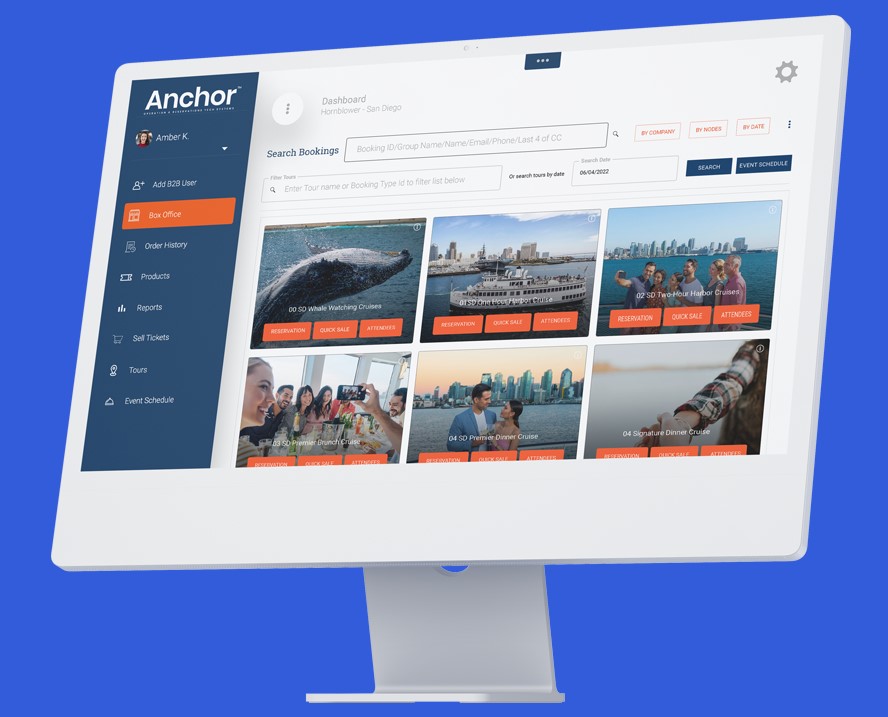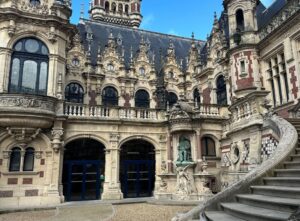One-on-one interview with Nasi Peretz at Anchor
Anchor has quickly become a major player in the business operations and reservation technology space. The company was born out of the Hornblower Group, which is synonymous with iconic sightseeing cruises. We sat down with Nasi Peretz, president and chief technology officer, to get a better understanding how Anchor came to be and its vision for the future of rez tech.
Destination EXP: Most people in the travel business know of Hornblower but would be surprised to learn of your different businesses. Walk us through the company’s portfolio.

Nasi Peretz: So, the Hornblower group is a very diverse group of businesses. We’ll start with the concessions, which are federal contracts that we have and that’s the Statue of Liberty, Alcatraz Island and Niagara Falls on the Canadian side. All three of those are concessions that are top attractions in the U.S. and in Canada, with attendance in the millions. Then we have the sightseeing cruise business across 22 ports in the US and with a fleet of over 254 vessels. And last but not least, is transportation which includes places like ferry transportation in New York, which is over 6.5 million passengers across 38 vessels, ferries in Puerto Rico, plus we do some military transport.
The American Queen division of the organization offers overnight excursions on vessels that take you up to Alaska or up and down the Mississippi. Those are beautiful voyages ranging from 7 to 14 days.
We have a business in Australia called Journey Beyond, which we acquired during the COVID time frame. They are focused on bringing Australia’s unique and iconic experiences to life. That’s experiential tourism with helicopters and one of the most interesting trains that crosses Australia. Journey Beyond has done an incredible job at showing what hospitality it should really look like in the post pandemic pickup.
Finally, during COVID, we found that it would be very opportunistic to pick up a couple of great acquisitions in the walking tour and food tour space, so we acquired Walks and Devour tours as a means to complement our other attractions.

DEX: You and a team came from Ticketmaster. How does that background influence how the company operates today?
NP: We came from Ticketmaster together to see if we could unify Hornblower’s initiative around ticketing to not be 12 disparate systems, but one single platform so that we’re really well-educated on our guests. Now we know that you went to the Statue of Liberty, but you also visited Alcatraz, have your anniversary on the 5th of May and he celebrates it typically on the water. Interestingly enough, our business accelerated during COVID because we had the luxury of having the Statue of Liberty shut down federally, and Alcatraz was shut down by the state of California. We took advantage of those time frames and pulled the plug on the old platforms and inserted the Anchor platform.
DEX: Why did you decide against using your existing technology?
NP: We started from scratch mostly because we didn’t see any of the existing ticketing platforms that we were using at the time across the business units satisfied 100% of their requirements. They all got there about the 90 percentile and that last 10% is really hard to close that gap.
So, we said let’s go here from the OPS folks on the ground from the call center, let’s go here from the salespeople and learn what the travel industry really needs around ticketing and then build it. There was an exploration phase that was about six months before we actually kicked off.
DEX: What do you think is the key differentiation between Anchor and other systems?
NP: The biggest change for us is that this is an OPS tool built by operators. The biggest differentiator feature wise is our superb reporting. We found that to be one of the biggest pain points across businesses that were looking for dashboarding and ad hoc reporting and then customized reporting. Previously they had to hire people to do it; hire an engineer and have a full-time data analyst running reports for them. We figured there shouldn’t be a need for that if you build the system properly.
We have over 700 toggles today on the platform that allow you to customize the system. Do you want an express checkout, do you want to ask for round trip? All these things are toggles in our platform. Competitors in the space that have over 20 years of hard coding or legacy code that’s been building up and it gets uglier and uglier over time.

Palais Benedictine in Fecamp, France is an attraction visited by the Hornblower Group.
DEX: Since every tour & activity business is unique, how do you accommodate for that?
NP: We wrap it into industry specific toggles, say hey the helicopter industry likes this, the maritime industry likes these 40 toggles and the walking tour industry needs these 30 toggles, then we’re not hard coding anymore, but instead we’re building a flexible platform.
DEX: When the platform rolled out there was initially some fear with operators who felt that their business competes against a Hornblower product in their destination. What do you say to them?
NP: We heard that concern upon launching at Arival in San Diego and we heard it loud and clear. Our data was already siloed, meaning anytime we onboarded a new client, it’s truly isolated, not just verified by us, but verified by ISO 27,001 compliance.
As of this year Anchor is no longer just within Hornblower. It’s its own company, its own PNL, its own bank. That separation was made so that people know that not only are you contractually separated or obligated to respect the data, but also in terms of business, in terms of compliance or completely isolating clients and never at any point competing with Hornblower.
For example, Blue and Gold is probably one of the biggest competitors for Hornblower. The anecdote that people used to say that Blue & Gold executives used to tell their employees, If you see a Hornblower employee walking down the street, you cross the street and walk on the other side. Low and behold, they’re now using the Anchor platform too.
DEX: We’re going to call upon your Ticketmaster experience. In the early days of concert ticketing there were a number of different options and eventually through acquisition and the strength of the platform, Ticketmaster became the de facto choice if you were going to go see Taylor Swift. Is that inevitable for the technology sector for tours and experiences?
NP: I think we’ll find that the leaders will bubble up. And they fit in one hand and we can name those companies, but we know that these five companies who are doing well by operators and are serving guests well will be the last ones to be standing.
The complexities you mentioned – some need to have OTA plugs, they need to make sure that they’re connected to all the payment gateways because different clients especially around enterprise run their own banking operations meaning they don’t use the cash flow model that you sustain the money and then you send it to me every couple days. You need to be integrated with every payment gateway.
Businesses need to have on-site technology like turnstiles and hardware and box office integrations. Not many companies can sustain that diverse of technology integrations. I think it’ll boil down to who has the scale to support the enterprise customers.
DEX: Many small operators didn’t get into this business because they love technology or they enjoy going over Excel spreadsheets. What three things should operators be looking for in a system?
NP: Number one, make sure that your brand is front and center. If you use any kind of commerce tool, make sure it’s not sending them away to a different site and make sure that that e-mail confirmation you received is your brand everywhere around it and not someone else’s.
Number two, make sure that this company distributes your ticket inventory across the board, not to two providers like Viator and Get Your Guide and that’s it. Niche or regional providers might have quite a bit of volume that might move that inventory for you.
Third is dynamic pricing. I think we all know now that your pricing strategy is the way to survive and to not base it all on static pricing. That’s certainly how airlines and hotels have come out of COVID and become profitable. If it’s a beautiful sunny day, there’s no reason your price for that kayak tour should stay the same.
For more information about Anchor, visit their website.






